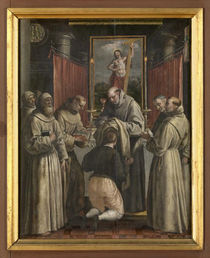The Catholic Defender: Saint Anselm Doctor of the Church
- Donald Hartley

- Apr 20
- 3 min read
Updated: Apr 22
Deepertruth with special permission and aid with Franiciscan Media, a great team for the Lord

Indifferent toward religion as a young man, Anselm became one of the Churn.ch’s greatest theologians and leaders. He received the title “Father of Scholasticism” for his attempt to analyze and illumine the truths of faith through the aid of reaso
The boy felt a profound religious calling during these years, spurred in part by a dream in which he met and conversed with God. His father, however, prevented him from becoming a monk at age 15. This disappointment was followed by a period of severe illness, as well as his mother's early death. Unable to join the monks, and tired of mistreatment by his father, Anselm left home and wandered throughout parts of France and Italy for three years. His life regained its direction in Normandy, where he met the Benedictine prior Lanfranc of Pavia and became his disciple.
At 15, Anselm wanted to enter a monastery, but was refused acceptance because of his father’s opposition. Twelve years later, after careless disinterest in religion and years of worldly living, he finally fulfilled his desire to be a monk. He entered the monastery of Bec in Normandy, was elected prior three years later, and 15 years later, was unanimously chosen abbot. Anselm became abbot of his own monastery in1079. During the previous decade the Normans had conquered England, and they sought to bring monks from Normandy to influence the Church in the country. Lanfranc became Archbishop of Canterbury, and asked Anselm to come and assist him. Considered an original and independent thinker, Anselm was admired for his patience, gentleness, and teaching skill. Under his leadership, the Abbey of Bec became a monastic school, influential in philosophical and theological studies.

During these years, at the community’s request, Anselm began publishing his theological works, comparable to those of Saint Augustine. His best-known work is the book Cur Deus Homo (“Why God Became Man”). Against his will, Anselm was appointed archbishop of Canterbury in 1093, at age 60. His appointment was opposed at first by England’s King William Rufus and later accepted. Rufus persistently refused to cooperate with efforts to reform the Church. In 1092, however, he was persuaded to do so. The following year, the king changed his mind and allowed Anselm to become Archbishop of Canterbury. But the monk was extremely reluctant to accept the charge, which would involve him in further struggles with the English crown in subsequent years. For a three-year period in the early 12th century, Anselm's insistence on the self-government of the Church – against the claims of the state to its administration and property – caused him to be exiled from England. But he was successful in his struggle, and returned to his archdiocese in 1106.
Anselm finally went into voluntary exile until Rufus died in 1100. He was then recalled to England by Rufus’ brother and successor, Henry I. Disagreeing fearlessly with Henry over the king’s insistence on investing England’s bishops, Anselm spent another three years in exile in Rome. His care and concern extended to the very poorest people. Opposing the slave trade, Anselm obtained from the national council at Westminster the passage of a resolution prohibiting the sale of human beings. Like every true follower of Christ, Anselm had to carry his cross, especially in the form of opposition and conflict with those in political control. Though personally a mild and gentle man and a lover of peace, he would not back off from conflict and persecution when principles were at stake.

In his last years, Anselm worked to reform the Church and continued his theological investigations – following the motto of “faith seeking understanding.” After his death in 1109, his influence on the subsequent course of theology led Pope Clement XI to name him a Doctor of the Church in 1720. On April 21, the Catholic Church honors Saint Anselm, the 11th and 12th-century Benedictine monk and archbishop best known for his writings on Christ's atonement and the existence of God. In a general audience given on Sept. 23, 2009, Pope Benedict XVI remembered St. Anselm as “a monk with an intense spiritual life, an excellent teacher of the young, a theologian with an extraordinary capacity for speculation, a wise man of governance and an intransigent defender of the Church's freedom.” St. Anselm, the Pope said, stands out as “one of the eminent figures of the Middle Ages who was able to harmonize all these qualities, thanks to the profound mystical experience that always guided his thought and his action.”





















Comments